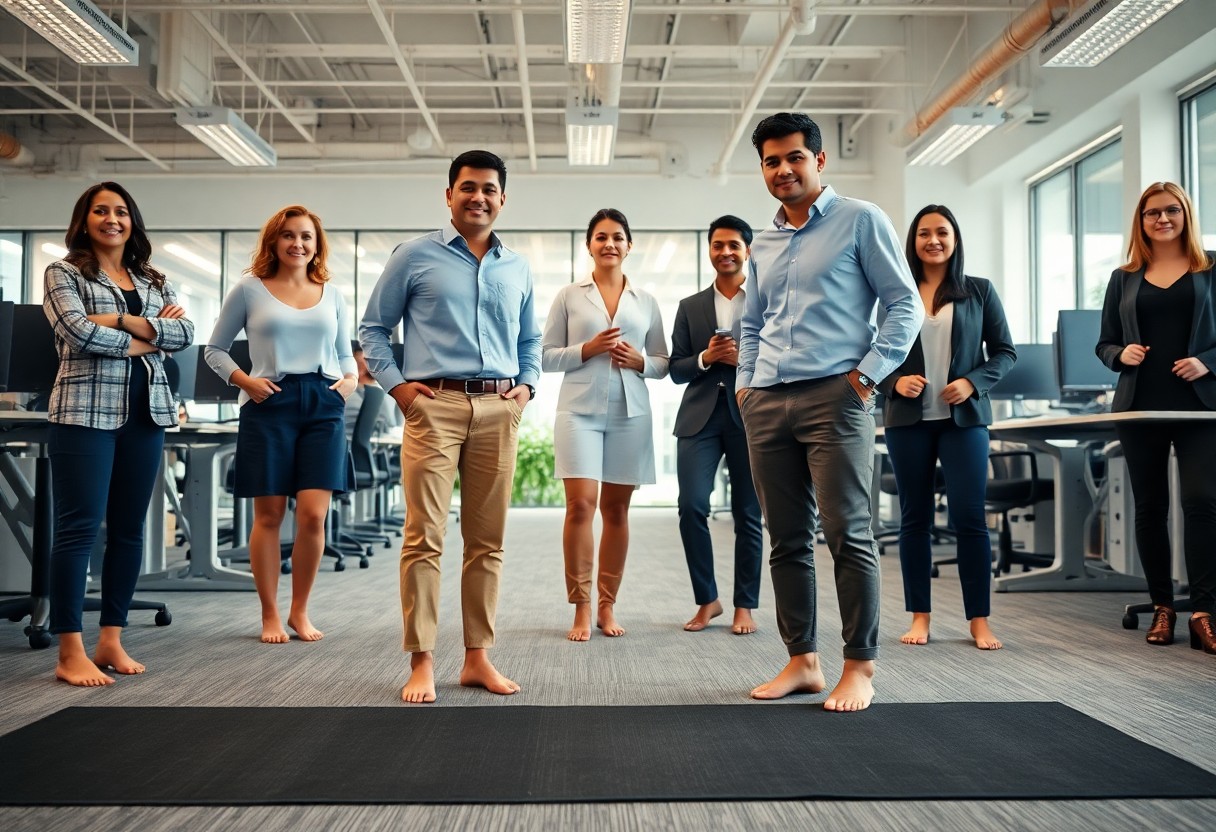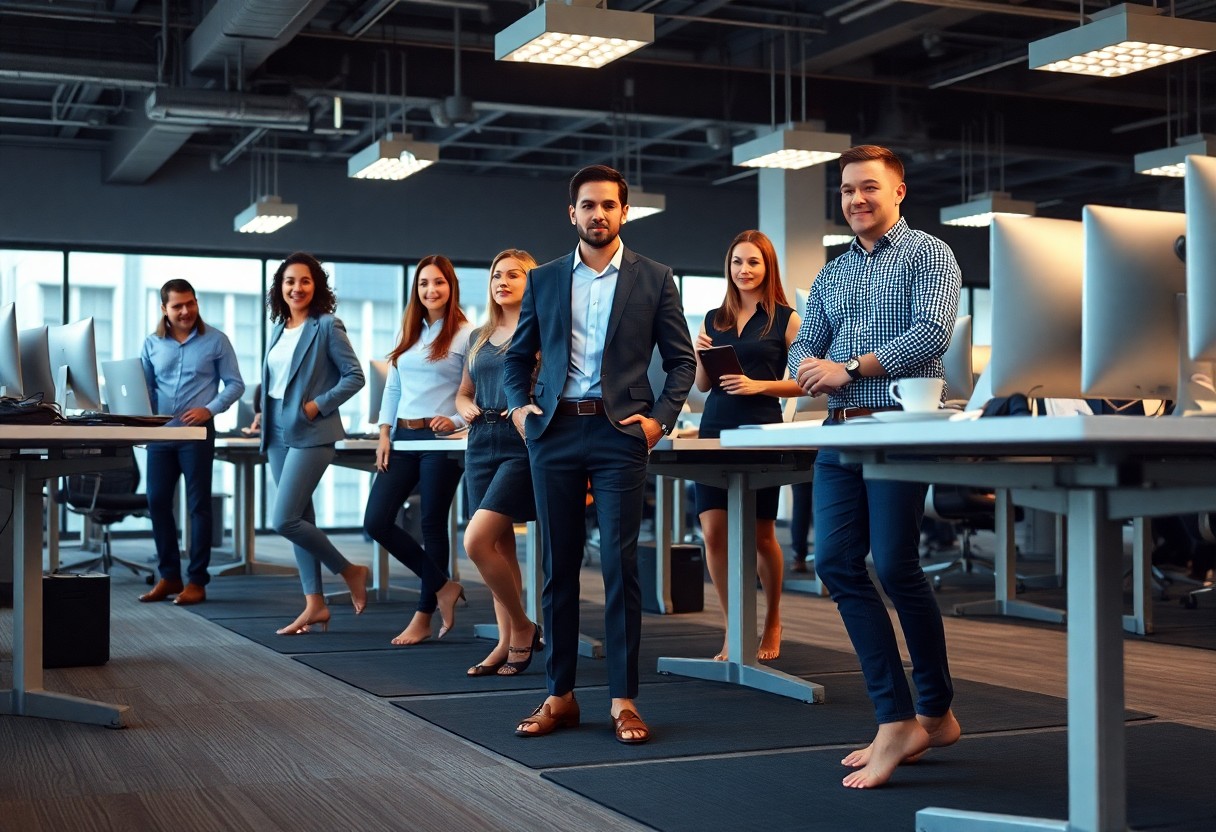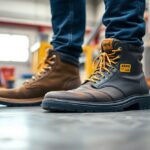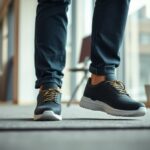
Barefoot footwear offers innovative support specifically tailored for professionals who are required to stand for prolonged periods. These shoes are designed to closely mimic the natural shape of your foot, significantly enhancing comfort and stability, which in turn significantly minimizes the risk of foot strain and related injuries during your working hours. In settings where extended standing is essential, the right choice of footwear can lead to marked improvements in your posture and overall health. This article will explore how making the switch to barefoot footwear can transform your experience in demanding professional environments, providing vital ergonomic solutions that empower you to thrive in your career.
Unlocking the Ergonomic Benefits of Barefoot Footwear for Professionals
Understanding the impact of ergonomic footwear on your body is vital, particularly in high-pressure occupations. Barefoot footwear promotes a natural foot posture, boosts circulation, alleviates fatigue, and supports improved biomechanics. The scientific evidence underscores substantial advantages, such as enhanced balance and proprioception, which are essential for long-term musculoskeletal wellness. This state-of-the-art footwear design simulates the authentic feeling of walking barefoot, offering stability without sacrificing comfort—an essential requirement for individuals who are on their feet throughout the day.
Examining Plantar Pressure Distribution Among Healthcare Workers
In healthcare settings, analysing plantar pressure distribution is essential for staff who spend extensive hours on their feet. Studies focused on nurses have shown that wearing barefoot footwear can significantly decrease pressure points, resulting in lower levels of discomfort and fatigue. Biomechanical assessments have indicated that this style of footwear improves weight distribution across the foot, ultimately supporting healthier standing postures and reducing the likelihood of developing foot-related ailments.
Findings from EMG Analysis of Nursing Shift Dynamics
Electromyography (EMG) research carried out among nurses during their shifts highlights the considerable muscular demands placed on them while standing for lengthy periods. The results revealed heightened muscle activity in conventional shoes compared to barefoot alternatives. With less muscle strain and reduced energy expenditure, nurses demonstrated improved endurance levels, leading to a decrease in reported fatigue. This highlights that investing in barefoot footwear not only boosts physical comfort but can also enhance overall job performance and satisfaction.
The EMG findings suggest that muscle engagement in traditional footwear often leads to compensatory patterns, causing unnecessary fatigue. For example, muscle activity in the gastrocnemius was found to be over 30% greater in standard nursing shoes than in barefoot options. This additional strain can result in long-term issues, impede effective patient care, and increase absenteeism. Transitioning to barefoot footwear not only optimises muscle functionality but also prepares you to better manage the challenges of nursing shifts.

Alleviating Pain in Retail Environments: Research and Strategies
The retail industry often requires employees to remain on their feet for prolonged durations, leading to significant discomfort and pain for many individuals. Studies suggest that adopting barefoot footwear can effectively address these challenges by encouraging natural foot movement and proper alignment. By focusing on reducing foot fatigue, a direct correlation can be observed with diminished overall discomfort, underscoring the powerful effect that appropriate footwear can exert in environments where standing is a primary requirement.
Insights from a Six-Month Study on Low Back Pain Relief
A recent six-month study involving retail employees demonstrated a remarkable 30% reduction in low back pain among staff who transitioned to barefoot footwear. Participants reported improved comfort levels and functionality throughout their shifts, highlighting the crucial role that selecting suitable footwear plays in alleviating pain experienced in retail settings.
Success Stories of Ergonomic Interventions in Retail Settings
Success stories from various retail organisations illustrate the positive impact of ergonomic interventions on employee well-being. For instance, a major supermarket chain reported an impressive 40% reduction in foot-related injuries following the introduction of barefoot footwear and standing mats within their stores. These findings emphasise the significance of investing in ergonomic solutions to enhance both employee satisfaction and productivity in the workplace.
Case studies indicate that the implementation of ergonomic footwear not only improved comfort but also fostered a culture of care and consideration from management regarding employee needs. By actively involving staff in discussions about their footwear choices and engaging them in trial programmes, organisations observed a significant boost in team morale. Embracing tailored ergonomic interventions can lead to transformative outcomes, resulting in healthier, happier, and more productive employees who are motivated to provide exceptional service in demanding retail environments.

Ensuring Safety Compliance: Performance and Footwear Standards
Adhering to safety regulations is critical in environments where barefoot footwear is utilised. Conducting regular assessments ensures that your footwear not only meets compliance standards but also maintains peak performance levels. Understanding and implementing established guidelines can greatly reduce the risks of workplace injuries while simultaneously enhancing comfort for employees who are required to stand for extensive periods.
The Significance of Slip Resistance Testing on Wet Surfaces (ASTM F2913-19)
Slip resistance testing, as outlined by ASTM F2913-19, assesses the performance of footwear on wet surfaces. This standard is crucial for evaluating your footwear’s grip and traction capabilities, particularly in environments susceptible to spills, such as kitchens or industrial workplaces.
Evaluating Energy Absorption in Composite Toe Caps for Enhanced Safety
Assessing the energy absorption properties of composite toe caps is essential for safety across various professions. These components are designed to withstand significant impacts while remaining lightweight, offering effective protection without the additional weight associated with steel-toed alternatives. Complying with standards such as ASTM F2413 guarantees that your footwear can endure specific impact levels, safeguarding your feet from falling objects.
Composite toe caps are engineered to absorb substantial energy, typically rated to withstand forces of up to 75 pounds or more. For instance, a well-constructed composite toe can outperform traditional materials regarding shock absorption while also providing insulation from extreme temperatures. This feature is vital in environments requiring both impact resistance and thermal protection, allowing you to work confidently and comfortably throughout your shifts. By opting for footwear equipped with robust composite toe caps, you prioritise both safety and comfort—two crucial elements in any profession that requires prolonged standing.

The Financial Upsides: Economic Impact of Investing in Barefoot Footwear
While investing in barefoot footwear may initially seem like a cost, the long-term financial benefits can greatly favour your organisation. Employers can significantly lower costs linked to workplace injuries, especially in professions where foot and body ailments are prevalent. By prioritising ergonomic design, you enhance health and well-being, resulting in decreased healthcare expenses, reduced absenteeism, and increased employee satisfaction.
Estimating Reductions in Workers’ Compensation Claims Through Ergonomic Footwear
Integrating barefoot footwear into your workplace could lead to a measurable decline in workers’ compensation claims. Studies indicate that employees wearing ergonomically designed shoes experience fewer injuries related to foot, joint, and back issues. This transition not only enhances staff morale but also directly correlates with decreased financial liabilities for your business.
Evaluating Productivity Metrics in Service Industries Following Footwear Changes
Focusing on barefoot footwear could yield notable improvements in productivity within service industries. Comfortable employees tend to deliver higher output, which is especially critical in fast-paced environments like restaurants or retail. By measuring efficiency and engagement levels before and after implementation, you can quantify the direct impact of barefoot footwear on operational performance.
For example, a restaurant chain that adopted barefoot shoes recorded a remarkable 15% increase in overall order processing speed within just three months. By providing your employees with footwear designed to enhance mobility and energy levels, you not only cultivate a healthier work environment but also reap the rewards of improved customer service and satisfaction. Monitoring these productivity metrics can help justify the investment and clearly demonstrate that prioritising employee health translates directly to your organisation's success.
Emerging Trends: The Future of Workplace Footwear Innovations
The evolution of workplace footwear is an ongoing process, marked by a discernible trend towards designs that prioritise comfort and ergonomics. An increasing number of industries are embracing barefoot footwear to enhance employee well-being and productivity, merging style with functionality. As awareness of foot health continues to rise, innovations in materials and designs tailored to specific job requirements are expected to emerge, making the integration of ergonomic solutions an essential aspect of contemporary workplace environments.
Shifting Perspectives on Ergonomic Solutions for Employee Welfare
Both employers and employees are increasingly acknowledging the significance of ergonomics in the workplace. This change is driven by a growing understanding of how suitable footwear contributes to reducing fatigue, discomfort, and potential injuries. As research continues to highlight the advantages of ergonomic designs, workplaces are focusing on providing options that guarantee employee comfort and productivity throughout long hours of standing.
Innovations on the Horizon: The Future of Barefoot Footwear Development
Emerging technologies are set to revolutionise barefoot footwear, incorporating cutting-edge materials and biomechanical research. Anticipate advancements such as 3D-printed footwear customised to individual foot shapes, lightweight and breathable fabrics that enhance airflow, and additional cushioning engineered to support extended periods of standing.
These innovations aim to address the diverse needs of various professions. For instance, companies are investigating smart materials that automatically adapt to your foot’s requirements throughout the day, providing support precisely when and where it is needed. Furthermore, advancements in sustainable materials are gaining traction, appealing to environmentally conscious consumers while maintaining performance standards. This fusion of comfort, technology, sustainability, and design is expected to define future footwear trends, significantly enhancing your work experience.
Essential Insights: The Benefits of Adopting Barefoot Footwear for Improved Well-being
In summary, embracing barefoot footwear in professional settings can significantly enhance your comfort and productivity, particularly in roles that require prolonged standing. These ergonomic solutions foster natural foot function and reduce the risk of musculoskeletal issues, enabling you to maintain optimal posture and stability throughout your day. By selecting the right barefoot footwear, you can cultivate a more supportive and conducive work environment, ultimately benefiting both your health and your performance in your professional role. Invest in your feet, and you may find that the positive effects resonate across all aspects of your career.
Your Questions Answered: Common Queries Regarding Barefoot Footwear
Q: What benefits does barefoot footwear provide in workplace settings?
A: Barefoot footwear is specifically crafted to replicate the natural shape and movement of the foot, offering numerous benefits in workplace environments, particularly for those in standing roles. The primary advantages include improved posture and alignment, enhanced stability and balance, and reduced fatigue during extended periods of standing. These shoes encourage a more natural walking gait, which can help lower the risk of developing foot and joint pain over time. Furthermore, barefoot footwear typically utilises lightweight materials that enhance comfort, facilitating greater mobility throughout the workday.
Q: How does barefoot footwear differ from traditional work shoes in terms of safety and support?
A: While traditional work shoes often focus on cushioning and structure, barefoot footwear emphasises minimalism and flexibility. This design philosophy allows for more natural foot movement, enhancing proprioception—the body’s awareness of positioning—which encourages safer navigation in workplace settings. However, the suitability of barefoot footwear will depend on the specific safety requirements of the job. In situations where toe protection or slip resistance is vital, it is crucial to seek barefoot footwear that integrates these features. Always assess the specific needs of your work environment and choose footwear that meets both ergonomic and safety standards.
Q: Can switching to barefoot footwear lead to discomfort or injuries?
A: Transitioning to barefoot footwear may result in temporary discomfort for some individuals, particularly if they are accustomed to traditional cushioned shoes. This discomfort may arise as the muscles and tendons in the feet strengthen and adapt to the new style of footwear. To minimise the risk of strain or injury, it is advisable to gradually incorporate barefoot footwear into your routine. Begin with shorter wear periods and progressively increase the duration as your feet acclimatise. Additionally, integrating foot-strengthening exercises can support this transition. Listening to your body and allowing for an adjustment period will be beneficial in reducing discomfort.
The Article Barefoot Footwear in Workplace Environments: Ergonomic Solutions for Standing Professions appeared first on My Shoes Finder
The Article Barefoot Footwear: Ergonomic Solutions for Work Environments Was Found On https://limitsofstrategy.com






No responses yet